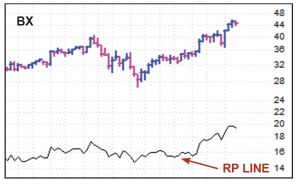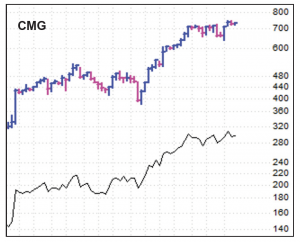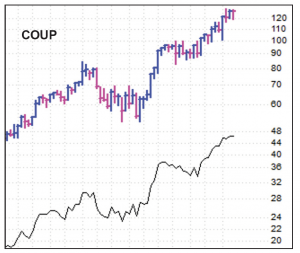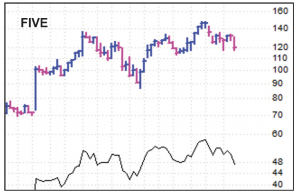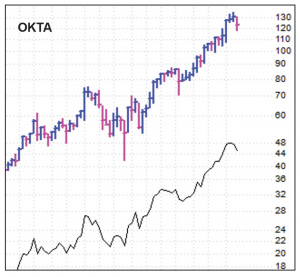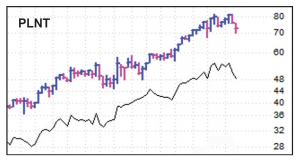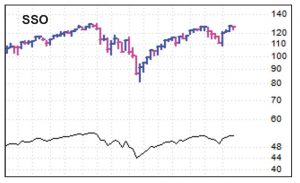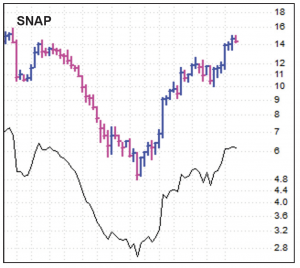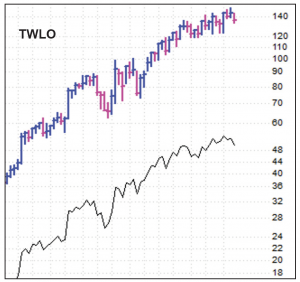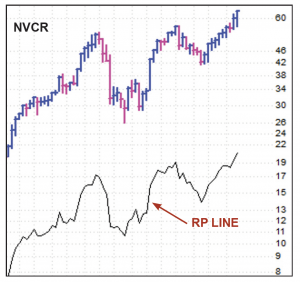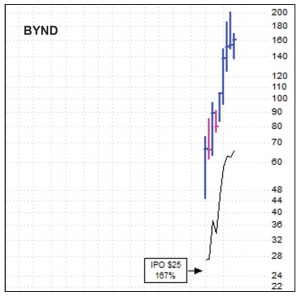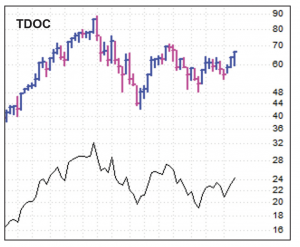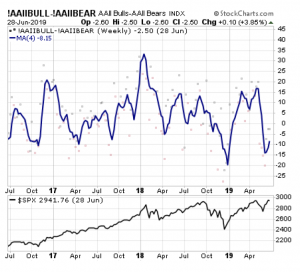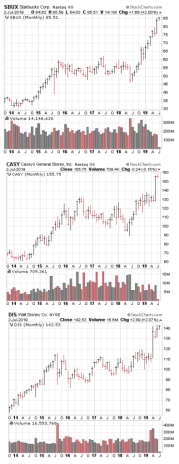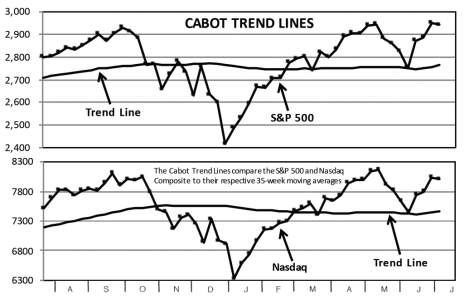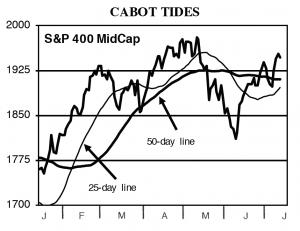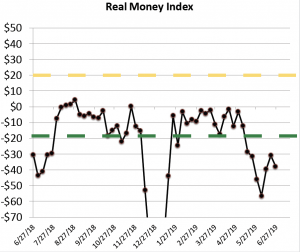As we begin the second half of the year, the odds continue to favor higher prices for the market down the road, so we remain in a generally bullish stance. Of course, the short-term will likely be news driven (trade talk, war fears and earnings season), but the big picture is looking sunny.
Individual growth stocks are a bit more divergent, with some looking tired but other, newer leaders looking peppy.
Cabot Growth Investor 1423
[premium_html_toc post_id="180960"]
The Odds Still Favor Higher Prices Ahead
It was a solid first half of 2019 for most major indexes and growth stocks. Despite a few knocks upside the head last week, our Model Portfolio finished June up nearly 22% on the year. In fact, since the start of 2017 (admittedly a good two-and-a-half-year stretch for growth stocks), the portfolio is up a bit more than 22% annually, more than eight points better than the S&P including dividends. We’ll take it.
Even so, we’re here to focus on the future and make sure we stay on the right side of things. On that front, the good news as we start the second half of the year is that the odds continue to favor higher prices ahead for the general market.
We say that partly because both of our trend-following indicators are still flashing green, and also partly due to the fact that, according to many sentiment measures, most investors aren’t embracing the rally (see page 6 for more). Even better, we’re still seeing some relatively rare market action that portends a continued bull run going forward.
One item that caught our eye this week, courtesy of Ned Davis Research: Over the past six months, both stock and bond prices are up more than 10%. Believe it or not, that’s only happened 10 other times since 1970, and the market did very well after that—the S&P 500 rose an average of around 11% during the next six months and nearly 19% looking out a year later. Just as impressive, the worst loss (using month-end prices) was just a couple of percent.
There are still some yellow flags (small caps are still rolling gutter balls), but overall, it’s a good bet to expect the bull market to continue, which is enough for us to remain mostly bullish.
But why not fully bullish? Mostly because individual stocks have gotten a bit trickier—some that have had multi-month runs are looking tired, while a bunch of fresher stocks are acting well. That’s not negative, per se, but it does tell us to carefully pick our stocks and entry points, especially as the next earnings season is right around the corner.
[highlight_box]WHAT TO DO NOW: Since the last issue, we’ve sold half of our Planet Fitness (PLNT) and all of our Five Below (FIVE), but we also filled out our position in Coupa (COUP) and, in tonight’s issue, are starting a half position in Snap (SNAP), which looks likes a new leader that could attract many big investors going forward. Our cash position will now be near 23%. [/highlight_box]
Model Portfolio Update
When everything is going up (be heavily invested, give your stocks room to breathe) or down (hold cash, limit new buying and tighten stops), managing the Model Portfolio is relatively straightforward. But the current environment is more nuanced—some growth stocks have lost steam and a couple have broken down, though many fresher names look just fine.
Market-wise, we remain very optimistic, but it’s really about individual stocks at this point, being tight with laggards and putting new money to work in stronger situations. Last week, we sold the rest of our FIVE and took half our profit in PLNT, but our newer buys (BX, Z, COUP) continue to act well. And tonight, we’re adding a new half-sized position in Snap (SNAP), which will leave us with around 23% in cash.
Current Recommendations
BUY—Blackstone (BX 47)—Blackstone has completed its transition from a partnership to a C Corporation, which makes it far more attractive to U.S. and even international institutional investors; indeed, volume on Monday and Tuesday was huge and the stock rallied as some of those big investors likely jumped in. As bullish as this transition should be, there’s far more to the story than that—Blackstone looks like a liquid leading Bull Market stock, benefiting from the rise in asset values and a heavy dose of acquisition and fundraising activity. In June alone, the company bought $18.7 billion of U.S. logistics assets from a big Singapore operation, raised $4.5 billion for a new energy credit fund and agreed to take a stake in a British operator of theme parks, attractions and resorts (including the LegoLand resorts). The company will report Q2 results (and its quarterly dividend) on the morning of July 18. Hold on if you own some, and if you don’t, you can start a position here, though with the 25-day line down near 43, a pullback of a couple of points isn’t out of the question.
BUY—Chipotle Mexican Grill (CMG 731)—CMG has been trading relatively tightly since its seven-day snapback to new price highs in early June. That action is fine with us, but should the market continue to push higher, we’d like to see the stock participate. Big picture, CMG has basically chilled out for the past three months (not much progress since early April), which looks like a reasonable rest period considering the prior run-up. Fundamentally, everything seems to be on track, and the next update will come on July 23, when the firm will report Q2 results (analysts are looking for sales to rise 11% and earnings of $3.76 per share, up 31% from a year ago). A drop back below 700 would probably have us going to Hold, while a dip into the 640 area may have us pulling the plug entirely. But right now, the stock acts well and we continue to think the next big move is up. We’re fine grabbing shares here if you’re not yet in.
BUY—Coupa Software (COUP 135)—Some cloud software stocks are looking a bit ragged, but Coupa is looking vibrant, with its quarterly report in early June unleashing a giant wave of buying (volume that week was COUP’s heaviest since it came public), and last week’s announcements surrounding its Pay service has attracted more big investors, pushing the stock to new highs. Beyond the news drivers, we think the firm offers what many institutions seek—growth that’s rapid, reliable and has a long runway ahead of it as more and more big companies sign up for (and expand their usage of) Coupa’s business spend management platform. We filled out our position late last week (buying another half-sized stake) and are holding on tightly to our shares. If you don’t own any, we’re fine taking a position here or (preferably) on dips of a couple of points.
SOLD—Five Below (FIVE 126)—It was a long, profitable run with Five Below, but we said adios to our small remaining position last week when the stock broke through its 200-day line. It’s bounced since, but our biggest thought with FIVE is that it’s no longer a leader—maybe it’s the valuation (49 times earnings), maybe it’s the uncertainty surrounding tariffs or maybe it’s something else, but the sellers repeatedly show up on every rally. Of course, retail stocks have been known to have nine lives, so if FIVE shapes up in the months ahead and the story/growth remains intact, we could always take another swing at it. But after practicing plenty of patience, we think there are greener pastures to play in.
BUY—Okta (OKTA 128)—Big picture, we think OKTA is probably in the middle innings of its overall advance, as the firm’s cloud-based identity offerings are an emerging gold standard in the cybersecurity industry. Indeed, one analyst hiked his target in late June, saying he expects more big enterprises to come on board. Shorter term, though, we’re keeping our eyes open, as (a) the stock’s big run, (b) last week’s three straight days of heavy-volume selling and (c) some sluggish action among other extended growth stocks could indicate a rest period is upcoming. Still, to this point, OKTA could only dip to its 25-day line before bouncing, which is hardly abnormal. Another wave of selling could have us booking partial profits, but as usual, we’ll go with the evidence in front of us, which today remains very bullish. We’ll stay on Buy.
HOLD—Planet Fitness (PLNT 77)—We took half our profit off the table with Planet Fitness last week after shares suffered four straight huge-volume down days, slicing through support in the process. Happily, the stock has bounced back decently, and we’re content to give our remaining shares some rope, with a mental stop in the mid-to-upper 60s. Fundamentally, nothing has changed, so we’re hopeful that, after some rest, the stock can continue higher. But PLNT hasn’t seen much selling this year, and so the recent downmove increases the odds of a deeper correction. If you sold some, practice some patience with your remaining position—and if you’re not yet in, we’d favor buying some other, stronger situations right now.
BUY—ProShares Ultra S&P 500 Fund (SSO 131)—As we mentioned on page 1, yet another rare occurrence has come together in the market, with both bonds and stocks staging excellent gains over the prior six months—and that has almost always preceded nicely higher prices over the ensuing six to 12 months. It’s not quite a blastoff indicator (those show rare changes in perception and overwhelming momentum), but consider it yet another study that portends good things. Plus, of course, our own trend-following indicators are green, with SSO itself kissing new highs today. Near term, there’s more uncertainty—the upcoming earnings season and the myriad news items out there are sure to push and pull the major indexes—but we continue to think SSO is a great way to play the overall bull move. We’ll stay on Buy.
BUY A HALF—Snap (SNAP 15)—We admit it’s unlikely that Snap will grow up to be another Facebook or Google, but that’s OK—there’s still great potential here, and the reason surrounds its appeal to young audiences. In fact, 75% of 13- to 34-year-olds use Snap’s popular app, which is more than even Instagram. The first couple of years of this stock’s life were brutal, but new management and a slew of new products (including more camera-based and some augmented reality offerings, video collections, games and even a bit of original content) and technology (including a new Android app that loads faster and has boosted engagement) helped the user count to increase in Q1 (to 190 million) and kept revenue growth strong (up 39% in Q1, expected to be up 30% to 40% both this year and next). Earnings are still in the red but quickly approaching breakeven, and the stock’s action is hard to ignore—it broke out to new recovery highs on the first day off the market’s June low, surged as high as 15 and has paused on light volume since. We’re starting a position here with an initial loss limit just under 12.
BUY—Twilio (TWLO 139)—TWLO still looks a bit tired to us, having fallen about 12 points when growth stocks came under pressure last week and failing to bounce much in recent days. We hate to keep flipping our ratings, but should the stock fall back into the low 130s we’ll go back to Hold, mostly because it would tell us the stock’s four-steps-forward, three-steps-back action of the past few months is still with us. (We’d still give our position plenty of rope before considering a sale, though, thinking higher prices are likely down the road.) That said, TWLO is standing on top of its 50-day line and, while it’s been tedious, the stock continues to form higher highs and higher lows over time. Throw in the fact that the growth story is as good as it gets and we’ll stay on Buy—but will be watching to see if buyers step up in the days ahead. Earnings are likely out in early August.
BUY A HALF—Zillow (Z 48)—Zillow took a brief hit last week when a couple of Fed members seemed to downplay the need for big rate cuts this month, but that turned out to be a shakeout, as shares have bounced back nicely since then. The housing market is obviously going to play a big role in the perception of this stock, but with the Fed likely to ease sooner or later, that should help the cause. And besides, Zillow is far more than just another housing-related stock—its new Offers business (and other ancillary services) has great longer-term potential no matter the short-term wiggles of housing activity and prices. Bottom line, Z continues to have the look of a new leader. We’re OK buying a half-sized position here, though we want to see more strength before averaging up.
Watch List
Carvana (CVNA 64): CVNA is now nine weeks into a new, more controlled basing pattern. A decisive show of strength could have us getting in. Earnings are likely out in early August.
Guardant Health (GH 86): GH certainly moves around a lot, but overall, it’s building a good-looking launching pad. The firm’s liquid biopsy tests should lead to booming growth for years in the pharmaceutical and clinical fields.
Novocure (NVCR 64): NVCR is a unique cancer treatment company, with a potentially revolutionary system (dubbed Optune) that’s able to undercut cancer cells via electrical fields. See more below.
Roku (ROKU 94): ROKU has pulled back sharply (but orderly) toward its 50-day line. We’re optimistic, but would prefer to see some buying power appear before stepping in.
Universal Display (OLED 191): OLED has returned to its volatile ways of late, but that’s been a good thing, with buying pressures picking up after its May correction. Some settling down would be good to see.
Other Stocks of Interest
The stocks below may not be followed in Cabot Growth Investor on a regular basis. They’re intended to present you with ideas for additional investment beyond the Model Portfolio. For our current ratings on these stocks, see Updates on Other Stocks of Interest on the subscriber website or email mike@cabotwealth.com.
Novocure (NVCR 64)—We wrote a month ago that it appeared medical stocks looked like new leaders; our first foray into the sector (Array Biopharma) ended up being a nice win. We can’t promise any more buyouts, of course, but there remain many enticing stories in the sector, and Novocure is one of our favorites. The company’s claim to fame is its Optune system, which is used on its own or in concert with chemo for a couple of cancer indications (for glioblastoma, a type of brain tumor, and for a rare form of mesothelioma, often linked to asbestos exposure). And it does so non-invasively, by using electrical fields (called tumor treating fields) that, at certain frequencies, have been shown to disrupt the cell division process and cause cell death. Better yet, the treatment itself is portable. Long-term, Novocure is studying Optune’s effectiveness on a ton of cancers (liver, ovarian, lung), but the two types it’s approved for now (the mesothelioma approval just came in May) are a big opportunity. At the end of Q1, 2,631 patients were using Optune (up 31% from a year ago), helping revenues to surge 41%. And analysts see plenty more where that came from, with sales likely to increase 35% to 45% both this year and next, and with 2020 bringing a meaningful profit (this year should see breakeven cash flow). As for the stock, it made no net progress for eight months and recently pushed to new all-time highs. NVCR is on our watch list; earnings are due July 25.
Beyond Meat (BYND 152)—Beyond Meat has been one of the hottest IPOs of the year, zooming as high as 200 a couple of weeks ago before backing off. The company is one of the leaders in the plant-based meat sector, and it’s developed recipes that replicate the look, texture and taste of a “regular” burger, meatball or sausage. (We tried a Beyond Burger on the grill and thought the texture was spot-on, and the flavor was solid. We gobbled up two of them—miles better than a veggie or bean burger in our opinion.) The corollary here is the plant-based dairy market, which now makes up around 13% of all dairy sales; some of that is due to allergies, but the meat market is far larger than dairy, so even if plant-based meats make up a smaller chunk of the industry down the road, you’re talking about a $120 billion-plus opportunity! Of course, there’s going to be a ton of competition, including from privately-held Impossible Foods (they supply the Impossible Whopper for Burger King) and big players like Tyson (launching its own plant-based protein brand), but the market is large enough for many players, and Beyond is one of the leaders in terms of brand name, distribution (30,000 retail locations, plus offerings at restaurants like Famous Dave’s, PizzaRev, Del Taco, Tim Horton’s and others) and product offerings (its new ground beef alternative was recently launched nationwide). Growth is massive (revenues up 215% in Q1), and the sky’s the limit if some big chains sign up. Back to the stock, it had a mini-blowoff on June 18 and we wouldn’t be shocked if it faded from here given the valuation ($9.7 billion market cap!)—but the longer it can hold up, the greater the chance that it can head higher from here. We’ll be looking for a few weeks of calm(er) trading to tell us the strong hands are back in control.
Teladoc (TDOC 67)—We wrote about Teladoc at the end of January, saying “we’re certainly not negative on the stock, but for us to take another swing at it, we’d need to see some rest and a proper setup.” In the five months since then, TDOC has mostly consolidated and is now taking aim at multi-month highs. Through both organic growth and a couple of major acquisitions (including Advance Medical last year, which gave it a big international footprint), Teladoc is the hands-down leader in virtual care, enabling patients to get in touch with a doctor (including many specialists) via videoconference and, in many cases, get run-of-the-mill prescriptions filled. The idea makes a ton of sense, saving people time and companies money, and Teladoc has put together an impressive network—40% of Fortune 500 firms have signed up, with over 100 insurance organizations and 300 hospitals on board as well. All told, customers have access to more than 50,000 experts and 7,000 clinicians. Subscription revenues make up the majority of business (26.7 million paid membership at the end of Q1, up 28% from a year ago), though the firm also gets some cash from visit fees; all told, revenue was up 43% in Q1 (up 23% excluding the Advance Medical buyout), and history has shown increasing adoption and usage from patients as time goes on. Back to the stock, TDOC it has acted much better since the market’s June low, and any decisive wave of buying (possibly on earnings, likely out near the end of this month) would be a good sign that the trend is turning back up.
Chart School: Deep Bases Lead to Shallower Bases
Carvana (CVNA)
We can’t remember a time when the market has done so well over a multi-month time period, and yet most investors remain either on the sideline or outright bearish. Year to date, our Real Money Index has recorded $78 billion of net outflows so far this year, including money being yanked four of the past five weeks as the market has rallied.
The assets in Rydex bullish funds (a narrower money flow measure) provides a clearer picture. Last September, when the S&P 500 and other indexes were hitting new highs, there was around $4.5 billion invested in these sector and leveraged long funds. When the S&P returned to its highs in early May, the dollar tally was just $3.8 billion. And today, with the S&P 500 back at fresh highs, just $3.5 billion!
Then, there’s the AAII survey, which, despite its small sample size, has a solid track record. Shown here is the four-week average of the net bullishness of individual investors—even after the huge June rally, they’re nearly as uneasy as they’ve been at any time in the past three years!
What’s causing all the angst? We think there are two main culprits. First, the overall market didn’t make any net progress from January 2018 through last week—17 months of wild action. Moreover, the vast majority of news flow over the past year has been either negative or uncertain. Chinese tariffs, Iran tensions, the Fed’s next move, political barbs and plenty of poor economic reports recently all send the same message: Trouble is here, or could be coming soon.
Of course, sentiment is and always will be a secondary measure. But with the major indexes at new highs, the lack of bullishness is a sign that relatively few weak hands are in the market and that a lot of money remains on the sideline—both things that should help the market move higher over time.
Long-Term Breakouts Are Often Solid Plays
We strongly believe in buying growth stocks that have the full combination of a great growth story (huge potential, etc.), excellent numbers (rapid sales growth, top-notch sub-metrics and ideally earnings) and a strong chart that’s offering a decent entry point.
But one purely technical way to find winners is by looking at long-term charts and buying as stocks decisively (key word) break out of multi-year consolidations; it’s best if the move comes on earnings or some other company-specific event. Even if the current fundamentals don’t seem all that attractive, our studies show these patterns lead to solid advances over time.
The classic example of late has been Starbucks (SBUX), which went dead for the three years ending October 2018 before soaring to new highs. Even the market’s Q4 implosion couldn’t pull it down much, and as the market improved in 2019, you can see the result—shares have marched steadily northward.
Two other ideas on this front: Casey’s General Stores (CASY) and Disney (DIS). First, with CASY, it’s the fourth-largest convenience store in the U.S., selling groceries, prepared food and gas—not exactly a huge growth business. But management has tightened up on spending and come out with some new initiatives that should help. Indeed, earnings have leapt north of 30% each of the past four quarters (Q1 saw 68 cents vs. estimates of 35!), with the Q1 report causing a breakout from a three-year consolidation.
DIS has much more pep to its story—the firm’s online streaming (Hulu and its new Disney Plus offering) and content (ESPN Plus) subscription services have a ton of promise. Earnings have shrunk each of the past two quarters and analysts see more shrinkage over the next 18 months as the firm invests in getting subscribers. Even so, we’re willing to bet that the stock heads higher—on the announcement of its streaming intentions in April, DIS barreled out of a four-year base and it remains in good shape today.
With other strong growth-oriented situations out there, we’re unlikely to take a stab at either CASY or DIS. But history tells us these stocks have recently undergone a big change in investor perception—a change that’s likely to produce solidly higher prices in the months ahead.
Cabot Market Timing Indicators
From a top-down perspective, the market remains in great shape, with the major trends pointing up and, encouragingly, zero signs of giddiness. Individual growth stocks have been trickier, but you should at least be leaning bullish given the positive vibes.
Cabot Trend Lines: Bullish
The Cabot Trend Lines remain clearly positive, as both the S&P 500 (by 6.4%) and the Nasdaq (by 7.2%) stand well above their respective 35-week lines. Interestingly, two weeks ago the S&P came close to triggering a 7.5% Rule green light (a type of blastoff signal), but couldn’t quite make it there. Even so, the more important point is that the longer-term trend remains up, so the odds favor higher prices ahead.
Cabot Tides: Bullish
Our Cabot Tides are also bullish, as some wobbles last week have given way to higher prices. Granted, the small- and mid-cap indexes—including the S&P 400 MidCap, shown here—are still lagging their larger-cap brethren, but even they are still holding north of their lower (25-day), rising moving averages, which is a plus. With the intermediate- and longer-term trends in gear on the upside, you should continue to lean bullish.
Cabot Real Money Index: Positive
As we write on page 6, sentiment remains a tailwind for the market—our Real Money Index is still in positive territory despite a month-long market rally, as the man-on-the-street refuses to jump onboard in any major way. In fact, he continues to pull money out of equity funds and ETFs! That’s a good sign relatively few weak hands are out there.
[premium_html_footer]
Send questions or comments to mike@cabotwealth.com.
Cabot Growth Investor • 176 North Street, Post Office Box 2049, Salem, MA 01970 • www.cabotwealth.com
All Cabot Growth Investor’s buy and sell recommendations are made in issues or updates and posted on the Cabot subscribers’ website. Sell recommendations may also be sent to subscribers as special bulletins via email and the recorded telephone hotline. To calculate the performance of the portfolio, Cabot “buys” and “sells” at the midpoint of the high and low prices of the stock on the day following the recommendation. Cabot’s policy is to sell any stock that shows a loss of 20% in a bull market (15% in a bear market) from our original buy price, calculated using the current closing (not intra-day) price. Subscribers should apply loss limits based on their own personal purchase prices.
Charts show both the stock’s recent trading history and its relative performance (RP) line, which shows you how the stock is performing relative to the S&P 500, a broad-based index. In the ideal case, the stock and its RP line advance in unison. Both tools are key in determining whether to hold or sell.
THE NEXT CABOT GROWTH INVESTOR WILL BE PUBLISHED July 18, 2019
We appreciate your feedback on this issue. Follow the link below to complete our subscriber satisfaction survey: Go to: www.surveymonkey.com/marketlettersurvey
Neither Cabot Wealth Network nor our employees are compensated by the companies we recommend. Sources of information are believed to be reliable, but are in no way guaranteed to be complete or without error. Recommendations, opinions or suggestions are given with the understanding that subscribers acting on the information assume all risks. © Cabot Wealth Network. Copying and/or electronic transmission of this report is a violation of U.S. copyright law. For the protection of our subscribers, if copyright laws are violated, the subscription will be terminated. To subscribe or for information on our privacy policy, call 978-745-5532, visit www.cabotwealth.com or write to support@cabotwealth.com.
[/premium_html_footer]



